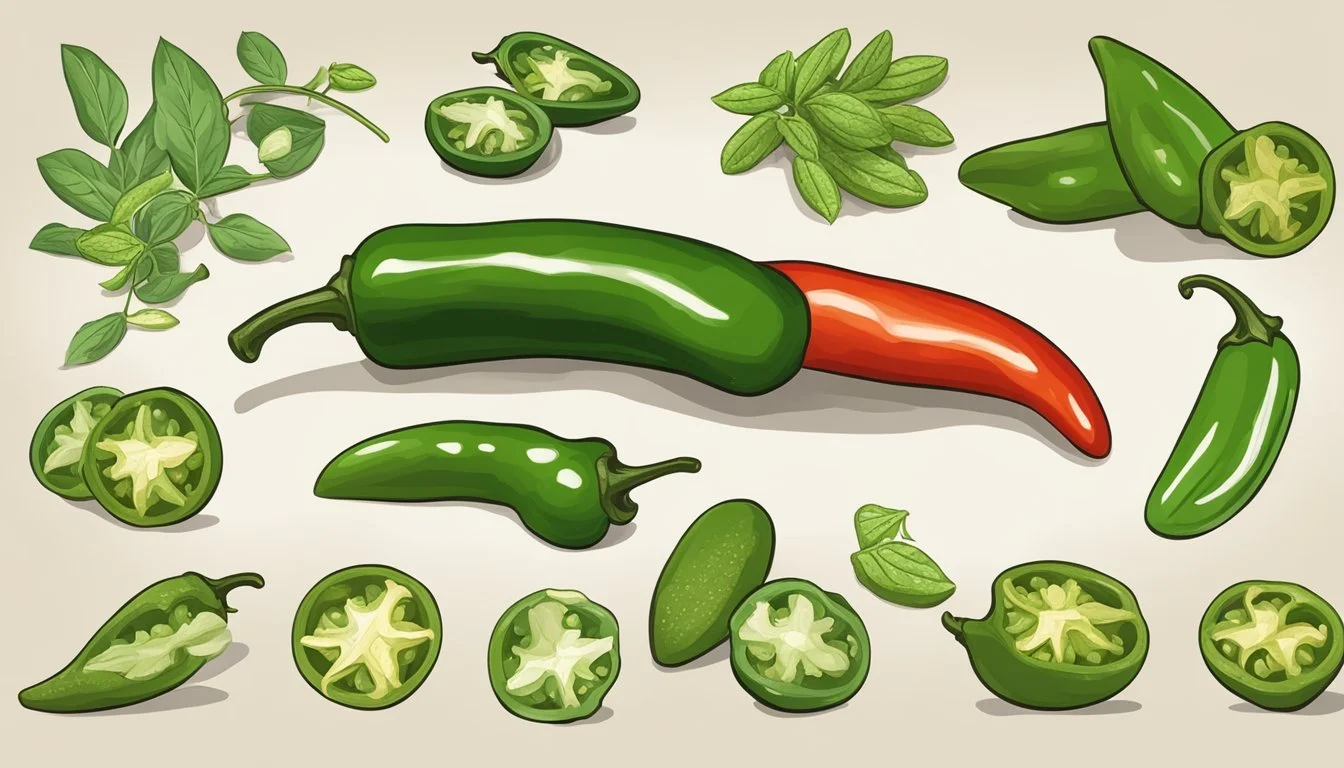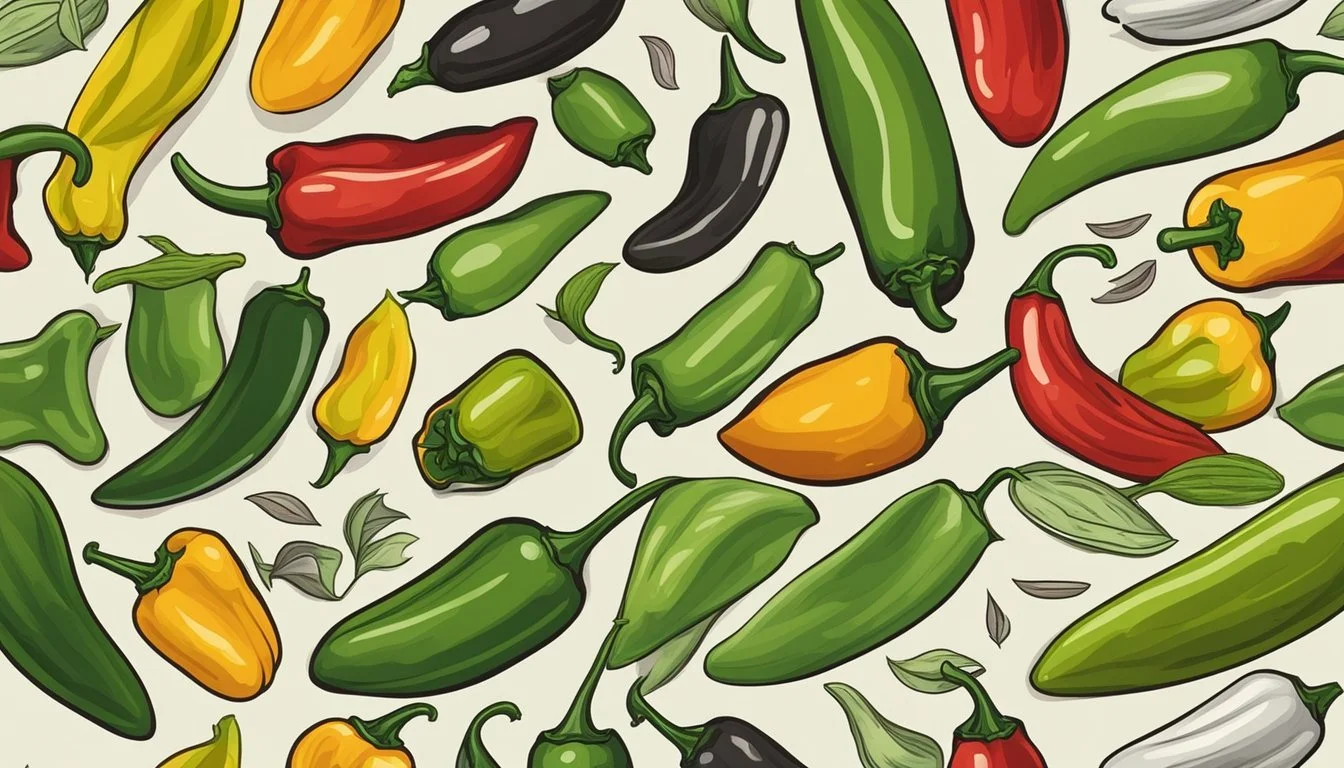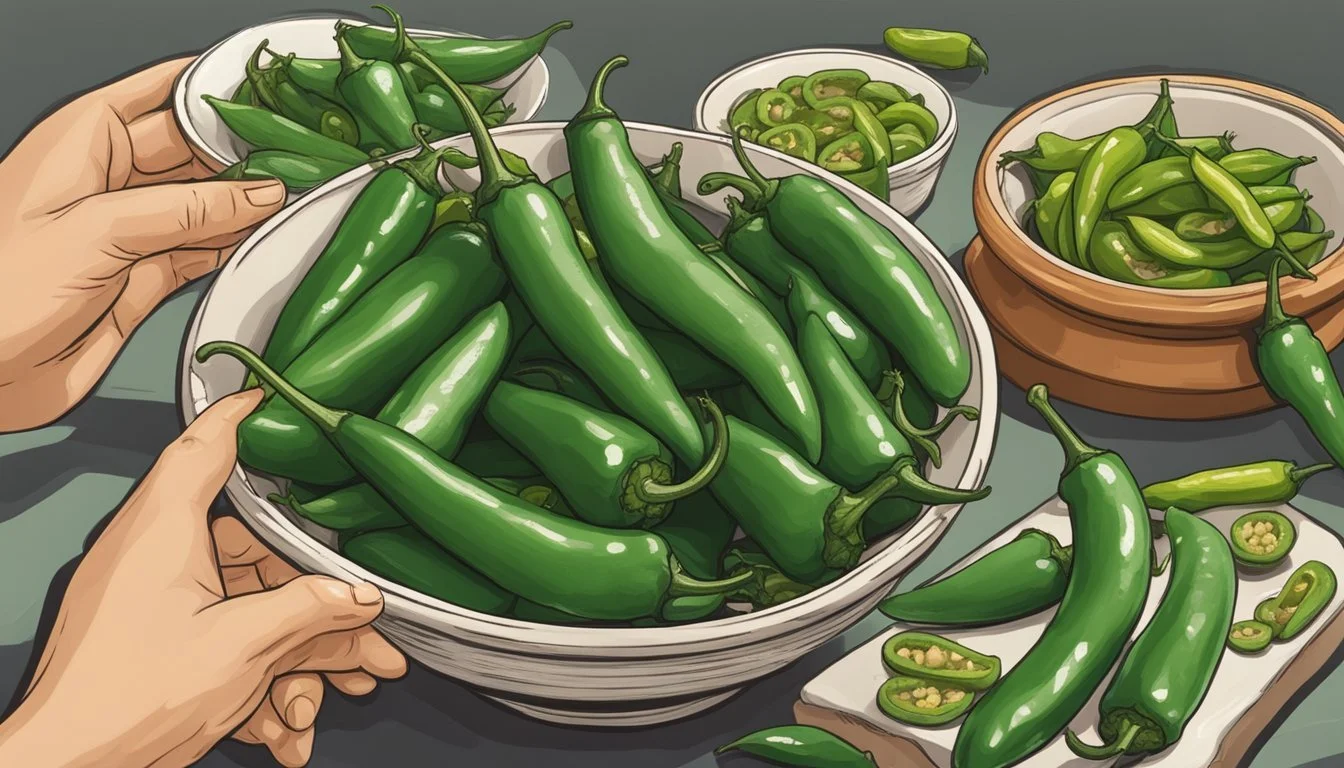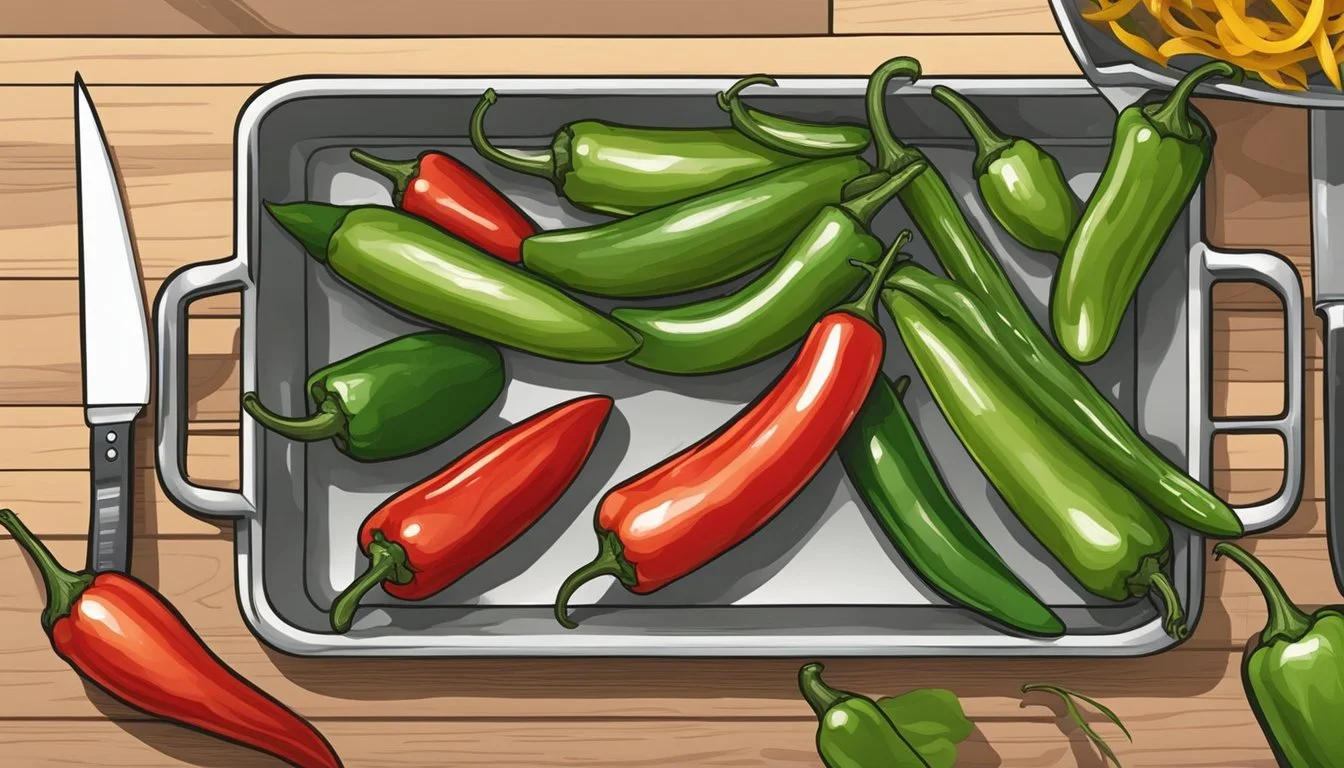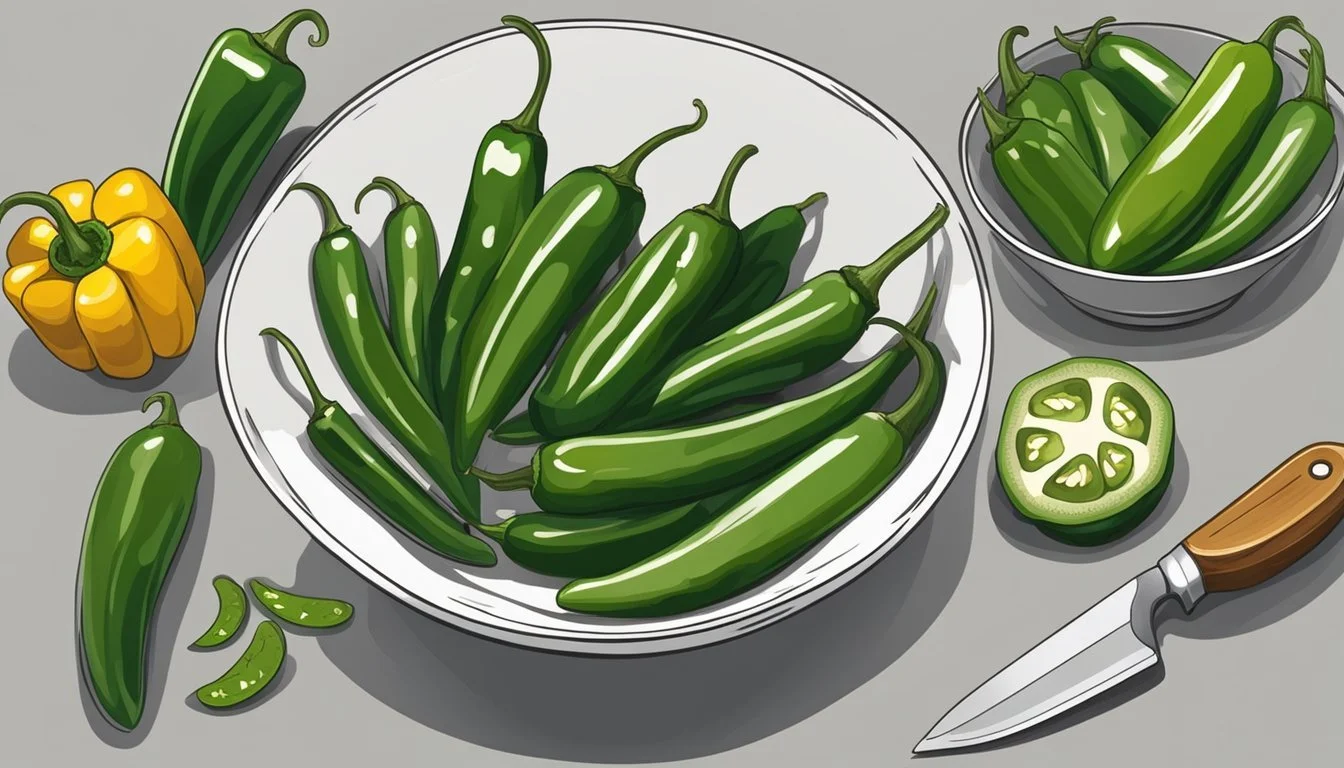How to Substitute Serrano Peppers for Jalapeño Peppers
A Spicy Switch Guide
In the culinary world, peppers offer a vibrant array of tastes, from sweet and mild to fiery and intense. Serrano peppers and jalapeño peppers, two staples in Mexican cuisine, are often at the center of these flavor profiles. While jalapeños are widely recognized and easily found in most grocery stores, serrano peppers bring a different level of heat and a more complex flavor that can enhance a variety of dishes. However, when a recipe calls for serrano peppers and only jalapeños are available, knowing how to substitute one for the other is a valuable skill.
Understanding the heat and flavor characteristics of these peppers is essential for a successful substitution. Jalapeño peppers, with their milder, sometimes slightly sweet heat, are a common household ingredient and can be a suitable substitute for serranos in many dishes. Serrano peppers, on the other hand, typically offer a sharper, more intense heat. When substituting jalapeños for serranos, a simple one-to-one ratio can serve as a starting point, allowing for adjustments based on personal heat tolerance and the specific requirements of the recipe.
It is important to consider the individual nuances of these peppers to ensure the integrity of the original dish. While both peppers share a green color when immature and offer a similar crunchy texture, the flavor intensity and heat level can vary widely. Jalapeño peppers have a Scoville Heat Unit (SHU) range that is generally less than that of serranos, indicating a milder spice level. This disparity in heat means that those desiring to match the fieriness of serranos may need to increase the quantity of jalapeños used, carefully tasting as they go.
Understanding Pepper Heat Levels
When substituting serrano peppers for jalapeño peppers, an individual needs to be aware of the different heat levels these peppers possess. Accurate measurement of spiciness is essential for achieving the desired flavor profile without overwhelming the dish.
Scoville Scale Basics
The Scoville Scale is the definitive method for measuring the heat of chili peppers, expressed in Scoville Heat Units (SHU). It quantifies the concentration of capsaicin, the chemical responsible for the sensation of heat. The higher the SHU, the hotter the pepper.
Capsaicin Concentration: Directly correlates with SHU.
Measurement: Professional tasters or high-performance liquid chromatography (HPLC).
Serrano vs. Jalapeño Heat Comparison
Serrano peppers typically range between 10,000 to 23,000 SHU, making them hotter than jalapeños, which range from 2,500 to 8,000 SHU. Below is a comparative summary:
Serrano Pepper: Ranges from moderate to high heat levels.
Jalapeño: Known for a lower heat level, suitable for milder palates.
Pepper Type Average Scoville Heat Units Serrano 10,000 - 23,000 SHU Jalapeño 2,500 - 8,000 SHU
Heat Level Comparison: Serrano peppers can be up to three times hotter than the mildest jalapeño. When substituting serranos for jalapeños, using half to two-thirds the amount of serrano is recommended to maintain a similar spiciness level.
Serrano and Jalapeño Flavor Profiles
When substituting Serrano peppers for jalapeño peppers, understanding their distinct flavor profiles is crucial for achieving the desired taste in culinary applications.
Taste Characteristics
Serrano and jalapeño peppers are staples in various cuisines, revered for their flavors, which offer both heat and distinct taste nuances. While similar, they possess unique characteristics that can influence the outcome of a dish.
Serrano Pepper Flavor
The Serrano pepper typically registers between 10,000 to 23,000 on the Scoville Heat Unit (SHU) scale. It presents a crisp, bright, and potent heat that is more intense than the jalapeño. The flavor profile of Serrano is marked by a grassy freshness that is suitable for salsas, chili con carne, and guacamole.
Jalapeño Pepper Flavor
In contrast, the jalapeño pepper measures between 5,000 to 8,000 SHU, offering a milder heat compared to the Serrano. Its flavor profile includes a distinctive, vegetal taste with a balance of heat and sweetness, making it a versatile chili pepper for a wide range of dishes, from stuffed appetizers to spicy sauces.
Substituting Peppers in Recipes
When adjusting recipes to substitute Serrano peppers with Jalapeño peppers, it's important to consider factors such as spice level, texture, and the final appearance of the dish. The following guidelines will help ensure the desired outcome is achieved.
General Replacement Guidelines
For a straightforward substitution, one can typically replace Serrano peppers with Jalapeño peppers on a one-to-one basis. However, because Jalapeños are generally milder, the recipe may require additional adjustments for spice.
Standard Conversion: Replace 1 Serrano pepper with 1 Jalapeño pepper.
Adjusting for Spice Levels
Serrano peppers usually have a heat range of 10,000 to 23,000 on the Scoville Heat Unit (SHU) scale, while Jalapeños are milder, typically ranging from 2,500 to 8,000 SHU. It may be necessary to use more Jalapeños to reach the desired heat level.
Spice Adjustment:
Mild: Use equivalent amount of Jalapeño.
Medium: Use 1.5 times more Jalapeño.
Hot: Double the amount of Jalapeño.
Considerations for Texture and Appearance
Texture and color are important in a dish's presentation. Serrano peppers are thinner-skinned and might have a brighter green hue when compared to Jalapeños. To maintain a similar texture, Jalapeños should be finely chopped. If the appearance is crucial, consider the color variation between the peppers, especially if Jalapeños have started to turn red.
Texture Match:
Chop Jalapeños finely to mimic the delicate texture of Serrano peppers.
Color Consideration:
Choose Jalapeños with bright, vibrant green skin for closest match.
Alternative Pepper Varieties
When substituting serrano peppers for jalapeño peppers, it's essential to consider the desired heat level and flavor profile. Different alternatives provide options to tweak these characteristics in a dish.
Milder Alternatives
For those looking for less heat, several peppers stand out:
Bell Peppers: The mildest option with a heat level of 0 Scoville Heat Units (SHU). They provide a similar crunch without the spice.
Anaheim Peppers: Offering a mild 500-2,500 SHU, they are a versatile choice for a range of dishes.
Poblano Pepper: Typically ranging from 1,000-1,500 SHU, they are another option that brings a mild heat to any meal.
Banana Peppers: Usually measured at 0-500 SHU, they add a tangy flavor and can be used in a 1:1 ratio.
Hotter Alternatives
For those who prefer a fierier taste:
Cayenne Pepper: Significantly spicier with a heat level between 30,000 and 50,000 SHU, suitable for those wanting to turn up the heat.
Red Pepper Flakes: A mix of peppers that can vary in heat, often used as a condiment, they can add a burst of spicy flavor to dishes.
Similar Texture and Flavor Alternatives
Certain peppers offer a balance of both texture and flavor that is similar to serrano peppers:
Fresno Peppers: Closer to jalapeño in appearance and heat, they provide a slight kick ranging from 2,500 to 10,000 SHU and are a good substitute for making poppers.
Cubanelle Peppers: Though they are milder at 0-1,000 SHU, they still maintain a similar texture to serrano peppers and work well in cooked dishes.
Shishito Peppers: Mildly spicy and often used in Asian cuisine, with 100-1,000 SHU, they are ideal for sautéing or grilling.
Incorporating Substitutes into Specific Dishes
When substituting serrano peppers for jalapeño peppers, it's important to consider the heat and flavor that each pepper brings to the table. Salsas and sauces may require fewer serranos due to their higher Scoville heat units, while soups and stews (What wine goes well with stews?) can benefit from the pepper's potent kick. In snacks, the balance between spice and flavor is pivotal.
Salsas and Sauces
In salsas and sauces, the substitution ratio is crucial. Beginners should start with a one-to-one substitution and adjust based on preference. For example:
Mild salsa: Replace one chopped jalapeño with one serrano.
Spicy sauce: Use two serranos for every three jalapeños for an elevated heat level.
Remember that serranos will impart a sharper, more intense heat.
Soups and Stews
Soups and stews often distribute heat throughout the dish, so substituting serrano peppers should be done judiciously. Begin with using half the amount of serrano as the recipe requires for jalapeño to ensure the heat doesn't overpower other flavors. For instance:
Vegetable stew: Half a serrano can replace one jalapeño to maintain the stew's savory profile.
Chicken soup: Stick to a one-to-one ratio if the recipe calls for a noticeable but not overwhelming kick.
A gentle simmer allows the pepper's essence to infuse into the broth.
Baked and Fried Snacks
For dishes like jalapeño poppers, where jalapeños are a central ingredient, substituting with serranos requires a nuanced approach:
Jalapeño poppers: Opt for one serrano per two jalapeños used. This ratio helps maintain the same spicy bite without overdoing it.
Spicy breaded snacks: A direct one-to-one substitution works if the recipe calls for diced peppers, as the frying process can mellow the serrano's heat slightly.
Bear in mind that the size of serrano peppers is generally smaller, which may affect the filling volume in snacks like poppers.
Shopping for Peppers
When substituting serrano peppers for jalapeño peppers, selecting the best quality is essential for achieving the optimal flavor and heat in your dishes. This section guides you on identifying fresh peppers and understanding their availability in supermarkets.
Identifying Fresh and High-Quality Peppers
Freshness is pivotal when shopping for peppers. A high-quality jalapeño pepper should have a firm, glossy surface with a vibrant green hue. Shoppers should avoid jalapeños with any signs of wrinkling or soft spots, which can indicate aging or poor quality. For serrano peppers, one should also look for similar qualities: firmness, vibrant color, and no blemishes.
Pepper Availability in Supermarkets
In most supermarkets, shoppers will typically find jalapeño peppers readily available in the produce section. They are among the most common chili peppers and are often sold alongside other varieties like the mild green bell pepper. Serrano peppers may also be available but can be less common. Here is a quick reference table for pepper availability:
Pepper Type Typical Availability Note Jalapeño High Located in the produce aisle. Serrano Moderate May need to visit a specialized store. Green Bell Pepper High Available as a milder substitute.
Shoppers should note that availability can vary based on location and seasonality. However, jalapeños and green bell peppers are usually stocked year-round due to their popularity in various cuisines.
Health and Nutritional Aspects
When substituting serrano peppers for jalapeños, one not only alters the heat level in a dish but also impacts the nutritional profile and health benefits.
Capsaicin and Health Benefits
Capsaicin is the active compound in peppers, including serrano and jalapeño, which belongs to the Capsicum annuum species. This compound is primarily responsible for the spiciness of the peppers and has been linked to various health benefits, such as pain relief and boosting metabolism. Serrano peppers generally contain a higher capsaicin concentration, which might enhance these benefits when used as a substitute for jalapeño peppers.
Pepper Nutrient Content
Peppers are a notable source of nutrients, including significant amounts of vitamin C and iron. Both serrano and jalapeño peppers contribute to the intake of these nutrients, which are vital for immune function and oxygen transport. Here is a comparison of their nutritional content:
Nutrient Serrano Pepper (per 100g) Jalapeño Pepper (per 100g) Vitamin C High High Iron Moderate Moderate
Both peppers, being variants of the Capsicum annuum species, offer similar nutritional properties. However, due to size differences, the substitution might result in a slight nutritional variation. One should consider the swap ratio to maintain nutrient balance in recipes.
Culinary Techniques and Tips
When substituting serrano peppers for jalapeño peppers, it is important to understand specific preparation methods which can influence the flavor profile and heat intensity of your dish. Roasting techniques, along with precise dicing and slicing, as well as pickling methods, are key for incorporating serrano peppers into various recipes such as salads, stir fry, pizzas, and sandwiches.
Roasting and Charring
Roasting or charring serrano peppers enhances their natural flavor and mellows their heat, making them a suitable addition to sandwiches and pizzas.
Salad: After roasting, chop the serranos and mix them into a salad for a smoky twist.
Pizza: Charred serranos offer a subtle heat and roasted taste to pizza toppings.
Dicing and Slicing
The size and shape of the diced or sliced serrano peppers impact the heat distribution in your dish.
Stir Fry: Thinly slice serranos to evenly distribute spiciness throughout the stir fry.
Sandwich: Diced serranos add a crunch and a punch of heat; use them sparingly.
Table: Serrano Cutting Guide
Dish Slicing Style Heat Level Stir Fry Thin slices Medium Sandwich Small dice Mild
Pickling and Preserving
Pickled serrano peppers are excellent for long-term storage and can be used to add zest to various dishes.
Green Chilies: Substitute pickled serranos for green chilies to add tang and mild heat.
Pickled Peppers: They can be sliced or diced before pickling to be used later in salads or as a condiment.
Quick Pickling Recipe:
Slice serranos into rings.
Brine: Combine 1 cup vinegar, 1 cup water, 1 tablespoon salt, and 2 tablespoons sugar.
Combine brine and peppers in a jar and refrigerate for at least 48 hours.
Cultural Usage of Serrano and Jalapeño Peppers
Serrano and jalapeño peppers are integral to various culinary traditions, offering distinctive flavors and heat levels. They can be found in fresh, cooked, and sauce forms across various dishes.
Peppers in Various Cuisines
In Mexican cuisine, jalapeño peppers are a staple. They're often used in their fresh form in dishes like nachos and tacos, or cooked to add depth to stews and sauces. Serrano peppers, on the other hand, are typically used where a sharper heat is desired. They are a common ingredient in fresh salsa, providing a more intense spice compared to jalapeños.
Outside of Mexico, both peppers have been incorporated into American, Spanish, and even Asian cuisines, where they add a distinct kick to a variety of dishes. In the United States, they're popular in Tex-Mex recipes, while in Asia, both peppers can be found in spicy stir-fries or as a side condiment.
Traditional and Modern Dishes
Traditionally, jalapeño peppers were used to make chipotles—a smoked jalapeno that is a key ingredient in many authentic Mexican dishes. Over time, their use has evolved, and they are now a key ingredient in homemade and commercial hot sauces, including famous brands like Tabasco and Cholula.
Modern dishes continue to showcase the versatility of both serrano and jalapeño peppers. Their use has transcended traditional Mexican cuisine, with jalapeños becoming a global ingredient used to spice up everything from pizzas to sandwiches, while serranos are often used in modern fusion dishes that require a bright, sharp heat.
Expanding the Flavor Palette
When substituting serrano peppers for jalapeños, one enriches dishes with a broader spectrum of heat and complex flavors. This can be achieved through strategic pairings with other spices and by experimenting with the level of smokiness.
Pairing with Other Spices and Herbs
Spices and herbs play a crucial role in complementing the fiery nature of serrano peppers. Integrating smoked paprika powder introduces a subtle smokiness while maintaining the pepper’s inherent zest. This addition pairs well with earthy herbs like thyme and oregano. Here is a suggested pairing to enhance the serrano pepper's flavor profile:
Smoked Paprika: Adds warmth and depth, excellent with meats and stews.
Cilantro: Provides a fresh contrast to the pepper's heat in salsas and salads.
Oregano: Offers aromatic notes that blend well with the kick of serrano.
Experimenting with Heat and Smokiness
Serrano peppers rank higher on the Pepperscale than jalapeños, typically between 10,000 to 23,000 Scoville Heat Units (SHU). To modify the heat level without sacrificing smokiness, one may incorporate acidic components like vinegar, which can cut through the spiciness. Here's a concise guide to adjust the smoky aroma and spiciness:
Vinegar: Mutes spiciness while adding tanginess; balsamic can add sweetness.
Smoked Paprika Powder: Increase or decrease for more or less smokiness, respectively.
By judiciously selecting complementary seasonings and adjusting smoky undertones, one can masterfully substitute serrano peppers for jalapeños, thus expanding the dish’s flavor palette.
Presentation and Garnishing with Peppers
Peppers provide both a visual and textural contrast in dishes, enhancing the overall appeal. Their various colors and shapes offer a palette from which chefs can finely tune the presentation of their culinary creations.
Using Peppers for Color and Texture
Color: Serrano peppers and jalapeño peppers vary in color, ranging from green to red as they ripen, offering a spectrum to enrich dish presentation. The serrano's vibrant green hue is especially striking when fresh, but chefs might opt for its red variant for a deeper color contrast.
Fresh Slices: Thinly sliced serranos introduce a sharp, crisp texture and can be artfully placed atop dishes.
Diced Peppers: Small diced peppers scattered across a plate contribute both color and a surprising texture.
Texture: The crunch of a fresh pepper adds a dimensional contrast to softer foods. If one desires a different texture, pickled serrano or jalapeño rings can be used. They offer a softer bite, which can complement rather than contrast certain dishes.
Pickled Pepperoncini: These can serve as a milder alternative, contributing a tangy flavor and a crunchy, yet slightly yielding texture.
Creating Visual Appeal in Dishes
Arrangement: The way peppers are cut and arranged on a plate greatly affects visual appeal. A chef might lay out finely julienned peppers in a deliberate pattern, or use rings of jalapeños as eye-catching garnishes on top of entrees and appetizers.
Strips vs. Rings: Long strips can lead the eye across a plate, while rings can frame or highlight a central ingredient.
Contrast and Complement: Peppers should contrast with the dish in color, but complement in flavor. A red serrano can stand out against a green salad, while a green jalapeño may be more subtle on top of a salsa.
Bold or Subtle: Choose a level of contrast that matches the dish's flavor profile—bold colors for bold flavors, or subtle shades for more delicate tastes.
By thoughtfully selecting and preparing peppers not only for their flavor but also for their aesthetic qualities, one can significantly elevate the presentation of any dish.


